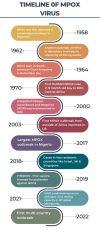Epidemiology, Virology, and Mutation Landscape of Monkeypox Virus From Past to Present
- PMID: 39328711
- PMCID: PMC11424752
- DOI: 10.7759/cureus.67872
Epidemiology, Virology, and Mutation Landscape of Monkeypox Virus From Past to Present
Abstract
Monkeypox (Mpox) has emerged as a significant threat to the global population. Initially identified in a rural area of Africa in 1970, after the eradication of smallpox, it spread rapidly across various African nations. The ongoing evolution of the monkeypox virus (MPXV), which causes Mpox, and its potential for cross-species transmission led to a global outbreak in 2022. Despite the control measures during the outbreak, Mpox cases continue in several African nations, posing a persistent public health threat. Global surveillance is crucial to eradicating MPXV from human populations and preventing its resurgence. Factors contributing to MPXV's increased transmissibility and immune evasion include its mutation rate, adaptability, and genetic evolution. Therefore, understanding the epidemiology and virology of Mpox is essential for developing effective prevention and control strategies. This study explores the history of human Mpox, the complexity of MPXV, how it replicates, and drug-resistant mutations. It will also stress how important it is to study how the circadian clock affects virus replication in infectious diseases in order to effectively fight this new public health threat. Understanding these aspects is crucial for developing effective strategies against Mpox as well as addressing the challenges posed by genetic mutations and resistance. The compiled information in this review underscores the critical need for continued research and monitoring to tackle the evolving dynamics of Mpox and its broader impact on global health.
Keywords: epidemiology of mpox; monkeypox; monkeypox virus; mpox; mpxv; orthopoxvirus; poxviridae infection.
Copyright © 2024, Mani et al.
Conflict of interest statement
Conflicts of interest: In compliance with the ICMJE uniform disclosure form, all authors declare the following: Payment/services info: All authors have declared that no financial support was received from any organization for the submitted work. Financial relationships: All authors have declared that they have no financial relationships at present or within the previous three years with any organizations that might have an interest in the submitted work. Other relationships: All authors have declared that there are no other relationships or activities that could appear to have influenced the submitted work.
Figures





Similar articles
-
Mpox: emergence following smallpox eradication, ongoing outbreaks and strategies for prevention.Curr Opin Infect Dis. 2025 Jun 1;38(3):222-227. doi: 10.1097/QCO.0000000000001100. Epub 2025 Jan 29. Curr Opin Infect Dis. 2025. PMID: 39878084 Review.
-
Molecular Virology of Orthopoxviruses with Special Reference to Monkeypox Virus.Adv Exp Med Biol. 2024;1451:111-124. doi: 10.1007/978-3-031-57165-7_7. Adv Exp Med Biol. 2024. PMID: 38801574 Review.
-
The resurgence of monkeypox virus: a critical global health challenge and the need for vigilant intervention.Front Public Health. 2025 May 30;13:1572100. doi: 10.3389/fpubh.2025.1572100. eCollection 2025. Front Public Health. 2025. PMID: 40520303 Free PMC article. Review.
-
The monkeypox virus-host interplays.Cell Insight. 2024 Jul 14;3(5):100185. doi: 10.1016/j.cellin.2024.100185. eCollection 2024 Oct. Cell Insight. 2024. PMID: 39144256 Free PMC article. Review.
-
Emergence of mpox in the post-smallpox era-a narrative review on mpox epidemiology.Clin Microbiol Infect. 2023 Dec;29(12):1487-1492. doi: 10.1016/j.cmi.2023.08.008. Epub 2023 Aug 11. Clin Microbiol Infect. 2023. PMID: 37574113 Review.
Cited by
-
The resurgence of monkeypox clade Ib: a global health emergency and concern.Arch Virol. 2025 Mar 21;170(4):84. doi: 10.1007/s00705-025-06270-0. Arch Virol. 2025. PMID: 40116967 Review.
-
From pox to protection: understanding Monkeypox pathophysiology and immune resilience.Trop Med Health. 2025 Feb 26;53(1):33. doi: 10.1186/s41182-025-00708-6. Trop Med Health. 2025. PMID: 40011970 Free PMC article. Review.
References
-
- The detection of monkeypox in humans in the western hemisphere. Reed KD, Melski JW, Graham MB, et al. N Engl J Med. 2004;350:342–350. - PubMed
-
- Monkeypox virus: ecology and public health significance. Khodakevich L, Ježek Z, Messinger D. https://www.ncbi.nlm.nih.gov/pmc/articles/PMC2491157/pdf/bullwho00071-00.... Bull World Health Organ. 1988;66:747–752. - PMC - PubMed
Publication types
LinkOut - more resources
Full Text Sources
Miscellaneous
